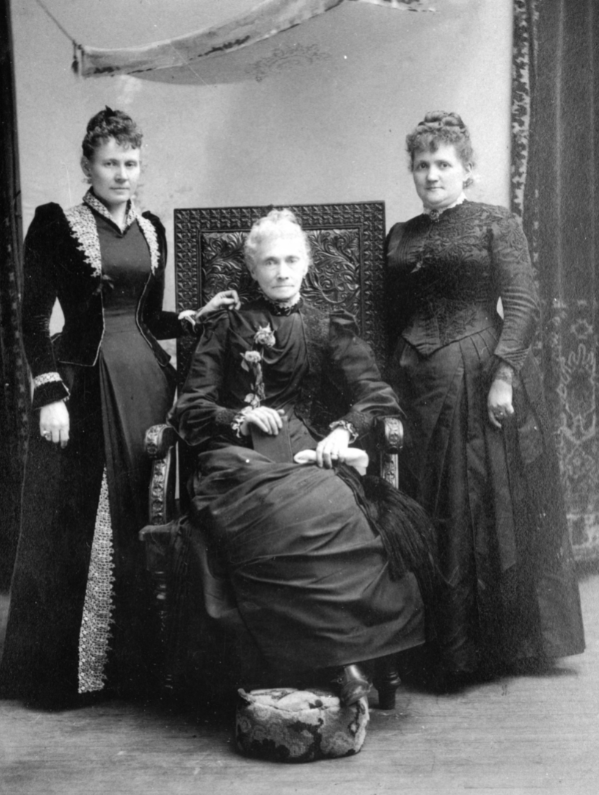Women in Utah were the first in the nation to exercise the right to vote. This happened in 1870–fifty years before the 19th Amendment secured voting rights for women.
In short
But suffrage is not a simple story. Women’s suffrage in Utah was tangled up with larger national political debates about women’s rights and polygamy. In fact, between 1870 and 1896, Utah women got the right to vote twice.
More of the story

Wyoming’s territorial legislature was the first to grant women the right to vote (or suffrage) in the United States, which they did in December 1869. Two months later, Utah’s territorial legislature unanimously approved a women’s suffrage law, making Utah the second territory to give women voting rights. However, Utah held a local election earlier than Wyoming did. This meant that Utah was the first place that women actually cast ballots in an election.
The first woman in the United States to cast a vote was Seraph Young. She was a schoolteacher and a relative of Utah leader Brigham Young. Even though Utah women could vote in elections, they did not have the right to run for office, yet.
Why Utah?
Women’s suffrage in Utah was closely tied to the Church of Jesus Christ of Latter-day Saints (LDS, also known as Mormon). Mormons were not the only people living in Utah Territory, but they were a majority. Many members of the LDS church believed in and practiced polygamy, a type of family in which one man marries more than one wife. However, many people inside and outside of Utah believed that polygamy oppressed women and the LDS church should end the practice. These disagreements about LDS polygamy had a strong impact on Utah’s suffrage movement.
Many LDS men and political leaders supported women’s voting rights in Utah. They believed granting women the vote would show the nation that polygamy did not oppress women. They also believed that LDS women would vote in ways that would give church members more political power in state and local elections. For this reason, the territorial legislature voted unanimously to grant women the vote–all the men in the legislature agreed that women’s suffrage would be good for Utah.
LDS people were not the only ones who wanted Utah women to have voting rights. Suffrage activists across the United States strongly supported Utah women in their efforts to gain voting rights in 1870. They believed that Mormon women would vote to end polygamy. In the end, however, they were wrong. After gaining voting rights in 1870, LDS women did not vote to end polygamy.
Voting Rights Lost

Utah women voted for seventeen years in state and local elections. Then in 1887, the US Congress passed the Edmunds-Tucker Act. This law included several measures designed to force the LDS Church to end polygamy once and for all. One of these provisions was taking away Utah (Mormon) womens’ voting rights.
Voting Rights Won a Second Time
Thousands of Utah women all over the state joined Utah’s second women’s suffrage campaign. Their efforts were a part of Utah’s final attempt to gain statehood. Mormon women worked closely with national suffrage leaders in the years leading up to statehood. Their goal was to convince male leaders that they deserved suffrage again because they had already helped the people of Utah by voting before. They wanted the future state’s constitution to grant women the right to vote.
Utah became a state on January 4, 1896. The new state constitution granted all Utah women who were considered US citizens the right to vote and to run for office. By 1897, women could vote in Wyoming, Utah, Colorado, and Idaho. Other states were slow to follow, however. Women across the country continued to fight for a national suffrage law for another twenty-four years. The 19th Amendment was finally ratified in 1920.
Although Utah gave a large majority of women voting rights in 1896, not all Utah women could vote–only women who held US citizenship. People who were not eligible to be citizens at this time included Native Americans and immigrants from Asian countries and the Pacific Islands. Women from these communities continued to work for change in the decades that followed statehood.
Voting rights were only a beginning. Suffrage alone did not provide women with full equality under the law. From the 1860s through today, Utah women have continued to organize and use their voices and their votes for change.
Keep Exploring!
Return to the Immigration and Expansion page here.
Return to the I love Utah History home page here.